Engagement Ring - In Progress
Setting
Stone
Limited Time: Purchase any Engagement Ring and receive a $250 Gift Card for your Wedding Band.
We guarantee that every single purchase directly impacts one person's life by giving them access to clean water.
Have you fallen in love with the tantalizing color of blue diamonds? From teal green to peacock blue to steely gray, there are some gorgeous stones out there. But did you know the value of your blue diamond engagement ring depends on whether it’s a natural, lab, or treated blue? Less than 1% of mined diamonds are naturally blue! So, knowing how your diamond got its color is really important. Let’s talk about how to buy the best blue gem for your money.
Did you know that the Hope Diamond is naturally blue? True story! Blue colored diamonds get their distinctive hue from invisible particles of a chemical element called “boron.” These tiny particles enter into the diamond crystal as it is being formed deep in the earth, turning it blue! So, there are natural blue colored diamonds. However, they are very rare (the Hope sits on a pillow at the Smithsonian Museum! I’ve seen it!). As a result, natural blues are very expensive. In fact, even extremely light natural blues sell for tens of thousands of dollars.
Instead, virtually all blue colored diamonds sold today (or at least all those under $20,000) have had a little help from gem scientists along the way. The fact is, while most people love the look of blue colored diamonds, not all of us can (or want to) afford something that rare. So, gem labs have devised two clever ways of giving us what we want, at a better value. The two most common types of blue diamond engagement ring chosen today are treated blues and lab blues!
Treated blues actually begin their lives as white diamonds with a warm color grade. Because these diamonds’ color grades are perhaps a little too warm for most people’s preference in a “white” diamond, diamond scientists snatch them up to color them! Gem scientists turn diamonds different colors by irradiating them. That is, they use special machines to change the very outer layer of the diamond’s crystal structure, making it blue. This treatment is safe, permanent, and results in a beautiful color. Treated blues are typically a distinctive, brilliant turquoise blue.
Did you know? Diamonds can be naturally colored by irradiation, too. One of my favorite Famous Diamonds, the Dresden Green, was naturally irradiated green by the Earth’s crust (in India)!
Diamond scientists have also recently discovered how to make lab grown blue colored diamonds! Lab blues are thoroughly blue diamonds made from scratch in a lab. They have the exact same chemical and visual properties as natural blues. Lab diamonds are made by placing a natural diamond “seed crystal” in a small chamber filled with common gases. When scientists want to create blue stones, they add boron. Once all the elements are added to the chamber, the elements are heated. As the heat rises, layers of blue diamond begin to form on top of the seed diamond crystal, making a large lab blue grow.
Just like natural blues, lab blues can range in color from light grey-blue, to bright medium blue, to dark green-blue. Because the color comes from boron, each lab blue is a little different! Both natural and lab blues are a 10/10 on the Mohs Hardness Scale, have unique inclusions, and individual colors. These new gems are quite miraculous – you can’t tell them apart from natural blue colored diamonds without further testing!
Couples looking for a beautiful blue diamond engagement ring will receive a great value from a treated or lab blue gem. Natural blues are the second rarest color in the world (only second to red)! As a result, they are very expensive. However, couples can enjoy the glamour of a blue colored diamond at a great value by choosing a lab or treated blue. Check out the difference in price!
| Natural Blue | Treated Blue | Lab Blue | |
| Per carat pricing | $40,000+/carat | $1,500-$4,000/carat | $1,500-$3,000/carat |
I speak with many couples who, after learning more about blue diamonds back in the States, wish they had purchased what they thought were natural blues down in the islands. Don’t worry. The blue diamonds sold down there are either lab or treated, too. Jewelers outside the United States often do not have the same disclosure laws we do. In other words, they may not be required to tell customers if the gems they are buying are treated. But, every blue diamond I have ever appraised from the islands has been a treated blue. And, given the rarity of blues, there’s no possibility of island stores being filled with natural stones. You’re good.
Because they are all diamonds, Natural, Lab, and Treated blues are all graded the same way. Check it out:
A diamond’s color is three things: its rainbow color, how light or dark it is, and how vivid or greyish that color is. In “fancy” colored diamonds, like blue, a diamond’s value increases with how deep and intense the color is. Most natural blues are somewhat grey. Most treated blues are greenish blue. Lab blue diamonds run the gamut! Every blue colored diamond color will start with the term “fancy,” for example “fancy light blue.”
Pro Tip: If you want to look like you have a natural blue, don’t go with something super bright. Natural diamonds like that are so rare that most jewelers and even auction houses have never seen them. In other words, people will assume a bright blue diamond is treated. Instead, if you want them to ogle and question, choose a lighter, grayer blue – this is what most natural blues look like!
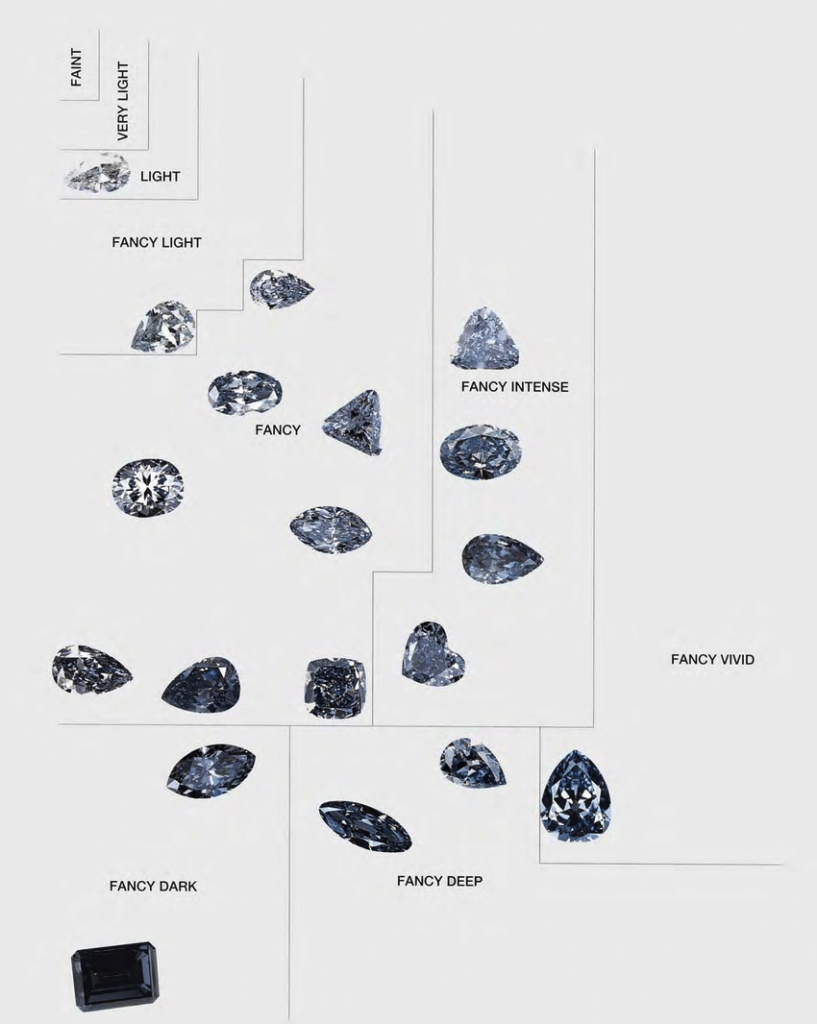
Diamond clarity is how “crystal clear” the diamond is. In other words, how many internal marks (“inclusions“) the stone has or doesn’t have. Couples should be aware that many (if not most) treated blue diamonds have pretty low clarity. In fact, these inclusions were one reason those diamonds were chosen to be irradiated blue. Sadly, clarity is often so low in these gems that you can see the inclusions with your naked eye. Not pretty. So, couples choosing treated blues should specifically look for VS clarity stones.
Natural and lab stones tend to have less inclusions than treated blues. Still couples should make sure that their gem is “eye clean.” In other words, that the stone’s inclusions are not visible to the naked eye. What clarity grade you need in order to have an eye clean stone will depend on your cut and your carat weight. Read more here about clarity!
Carat weight is a measurement, not a size. So, couples should always look at the physical measurements of a stone to see how large it is instead of trusting its carat weight. As we’ve noted, natural blues are incredibly rare. So, you’ll see very high prices for gems even as small as 0.10ct. Treated blues and lab diamonds can come in much larger sizes for better prices.
In addition to the shape of your diamond, “cut” means how well the diamond’s angles align with each other to reflect light. We suggest couples look for “Excellent” cut GIA diamonds, which offer great sparkle and light return. However, there are nuances to every shape – tips and tricks of the trade, if you will. So, once you decide on your shape, visit our Resources section to learn how to get the most sparkle and bang for your buck.
While blue-colored diamonds make an attention-getting center stone, they can also be used as side stones or wedding band sparkle, too! One of my favorite looks currently is a double halo, with one halo being colored. So, if you think having a little color in your engagement ring is right up your alley, maybe try blue! If you don’t want too much, though, some smaller stones around a white center really add a nice pop of color.
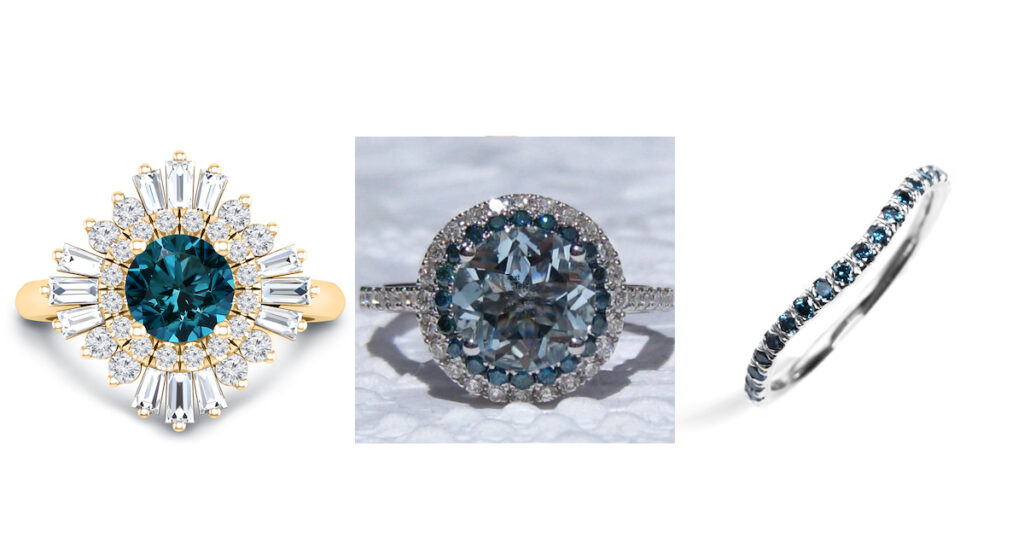
There are other blue engagement rings too! Couples looking at blue diamond engagement rings should also consider Blue Sapphire, Blue Topaz, Blue Spinel and Aquamarine. All of these gemstone engagement rings are blue, durable, and beautiful. Sapphire is one of the hardest minerals on the planet, making it a great blue diamond alternative. Also, couples should know that Blue Sapphire and Blue Spinel are typically more richly colored than Diamond. So, those looking for a deep, royal blue may find Sapphire or Spinel more to their liking. Finally, Topaz and Aquamarine are both wonderfully affordable options that come in very large sizes. This is great for couples looking for a big look at a great value.
I can! And I will! My name is Corinne, I’m the gemologist, and I love this! Although Do Amore does not have blues listed on our site, if it’s what you want, it’s what we’ll get you! Shoot me an email here, and I’d be happy to discuss blue diamond engagement rings with you. We can discuss what you’re thinking, what style you’re going for, and design the perfect blue engagement ring within your budget. Then, I’ll perform a custom search of available blues just for you.
Verifiably Ethical & Sustainable
Guaranteed 1:1 Impact
Personalized 1:1 Customer Service
handcrafted & american-made
you before us, always
Verifiably Ethical & Sustainable
Guaranteed 1:1 Impact
Personalized 1:1 Customer Service
handcrafted & american-made
you before us, always
Thoughtfully crafted, made to last, and designed for life's most meaningful moments. LEARN MORE
Diamonds, Gemstones, & Metals
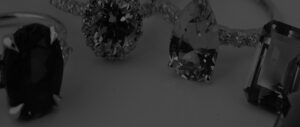
Every piece of Do Amore jewelry begins by not hurting the world. All our natural diamonds are either ethically sourced in Canada, recycled to eliminate additional demand, or accompanied by a blockchain ledger showing every hand your diamond passed through, proving your stone is truly conflict-free.
We also offer sustainable lab-created stones and guarantee all precious metals are recycled to eliminate the environmental impact of mining. Since March 2022, we carry absolutely no Russian diamonds and continue to urge the industry to follow suit.
Clean Water
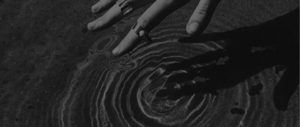
We desire to deepen the well of love in the world. We guarantee that every single purchase—whether engagement ring, wedding band, or piece of jewelry—directly impacts one person’s life by giving them access to clean water.
We do this by directly matching jewelry purchases to people in communities to ensure our funding has a one-to-one impact. We also show you the exact GPS coordinates and a photo of the water well your ring or piece of jewelry helped fund.
Customer Service

As a small, 100% founder- and employee-owned team, one-to-one encounters are at the heart of our values. Whichever way you want support throughout your engagement ring or jewelry purchase process, our team is here to accommodate you.
From high-touch to hands-off, video calls to text messages, you have our dedicated, responsive team on your side from the moment you start your search, to the day your well is built, to the time we meet again.
Engagement Rings, Bands, & Jewelry
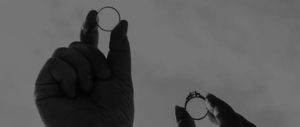
Every Do Amore design, whether one of our own or unique to you, is beautifully handcrafted in America and made specifically for you. Each ring is made to order, every time.
From classic to custom, you have the option to select from dozens of gorgeous settings or work with our design team to create something entirely bespoke. Plus, you are always covered for free inspections, polishing, cleaning, stone tightening, rhodium-plating, and resizing for life.
Our Promise

We care about what matters most to you, not what’s easiest for us. If it’s a minor change to a setting or arriving at a completely custom design, we work to ensure you get precisely what you love.
From statement-making to understated, we have options at any price point. Plus, you always have our team on your side searching to bring you every stone within your specifications. We also offer 60-day returns and a limited lifetime warranty to cover you in the rare event of a manufacturing defect.